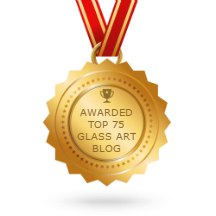Glass fusers are taught from the very beginning to keep precise records of each firing recording the type of glass, the fusing schedule and notes on what happened. Then, once you get to know your kiln well, you will learn which pieces require which schedules. What I didn’t realize is that this learning never really stops. I have been using a full fuse schedule of 1460 degrees F for most of my plates, bowls, coasters, night lights, jewelry, and so forth for the last several years. Basically, if I wanted a 6mm piece at full fuse, I took my kiln to 1460 degrees F.
Recently I was on a roll with coasters and started to notice a difference in the resulting coasters. The first set of coasters to catch my eye was a set of Bullseye special glass coasters which mixed opaque glass with transparent glass. I noticed that even though I started with a perfect square, I ended up with not a perfect square – basically lopsided. So I decided to do some more testing and made a single coaster with aqua blue transparent and another with aqua blue opaque taking them 1460 degrees F. This time, the result was consistent in that the general shape was a consistent square, but I noticed that I was getting a little pull in on the sides especially with the transparent aqua blue glass. Hmm. Perhaps this had been happening for a while and I just hadn’t noticed.
Often, glass pulling in on the sides is a sign of firing too hot. So the next set of coasters I decided to try fusing them at 1425 degrees F. I had always thought that 1425 degrees F was more for an aggressive tack fuse and have used it successfully this way for large platters. But with 4 inch coasters, 1425 degrees F was enough to fully fuse the coasters and instead of their pulling in on the sides, they remained perfectly square with nicely rounded corners. Hence, I am now using less heat for my smaller pieces with better success.

Fused Glass Coaster Experiments
Here is what I believe I have learned:
- Smaller objects require less heat to fully fuse. While a large 6mm platter may need 1460 degrees F in my kiln for a full fuse, smaller coasters and other small objects can be fully fused at 1425 degrees F.
- Most transparent glass is softer and hence spreads the most and requires less heat to fuse.
- Black fused glass is the stiffest and requires hotter temperatures to melt and fuse with opaque glasses somewhere between transparent glasses and black glass.
- If you are using a streaky glass that includes both transparent and opaque colors, accept the fact that it won’t end up square at high temperatures and if it stresses you out, grind it square again and then just fire polish the edges.

Fused Glass Coasters Fired at 1425 degrees F (available in my Etsy Store)
NOTE: I learn much of what I know from reading other websites, classes and blogs and hence, I haven’t really invented anything new here. But I am sharing what I found to work and not work. If you have found other ways to do something similar to this, please share. Thanks!
Read Full Post »



